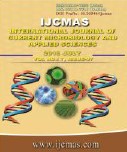


 National Academy of Agricultural Sciences (NAAS)
National Academy of Agricultural Sciences (NAAS)

|
PRINT ISSN : 2319-7692
Online ISSN : 2319-7706 Issues : 12 per year Publisher : Excellent Publishers Email : editorijcmas@gmail.com / submit@ijcmas.com Editor-in-chief: Dr.M.Prakash Index Copernicus ICV 2018: 95.39 NAAS RATING 2020: 5.38 |
Field experiments was conducted during rabi 2012-13 at Pulse Research Area of CCS Haryana Agricultural University, Hisar to study the heat unit required in relation to phenology of chickpea cultivars as influenced by sowing time and seed rate. The experiment was laid out in a split plot design with two sowing time (1st fortnight of November and 1st fortnight of December) and four cultivars (H09-23, H08-18, C-235 and HC-1) kept in main plots while three seed rates viz. 40 kg ha-1, 50 kg ha-1 and 60 kg ha-1 were kept in subplots and replicated thrice. In the present investigation, important variabilities in terms of growing degree days and helio thermal unit were observed. The results indicated that November sowing resulted in higher value of growing degree days and heliothermal unit to attain all the phenophases except at maturity where the values were higher in December sown chickpea as compared to November sown. Chickpea cultivar HC 1 required highest GDD to achieve seedling emergence, 50% flowering and podding whereas cultivar H09-23 required lowest value. Cultivar H09-23 produced highest grain yield when sown in 1st fortnight of November (2,314 kg ha-1). Delay in sowing time significantly reduced the grain yield of C235. In case of 1st fortnight of December sowing, cultivar HC-1 (1740 kg ha1) performed better in terms of grain yield followed by H09-23 (1,675 kg ha-1). With all the cultivars, delay in sowing reduced the stover yield and it was significantly reduced with 1st fortnight of December sowing of all the cultivars. Cultivar H08-18 produced significantly higher stover yield than the other cultivars at 1st fortnight of December sown chickpea.
 |
 |
 |
 |
 |